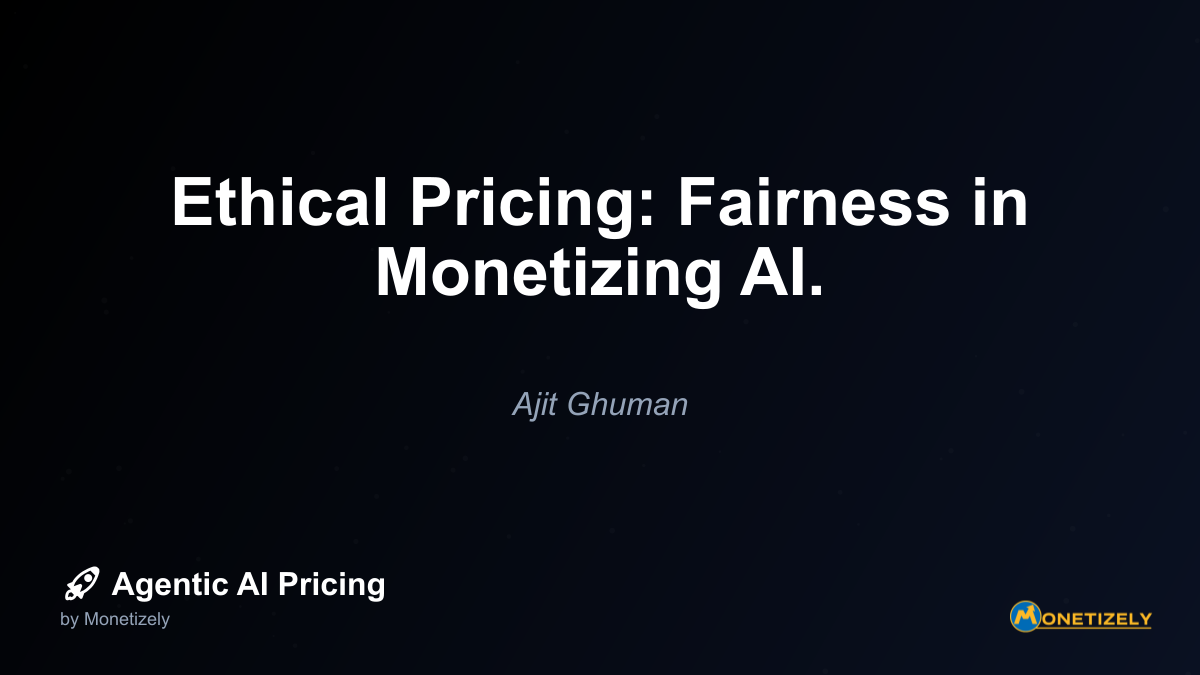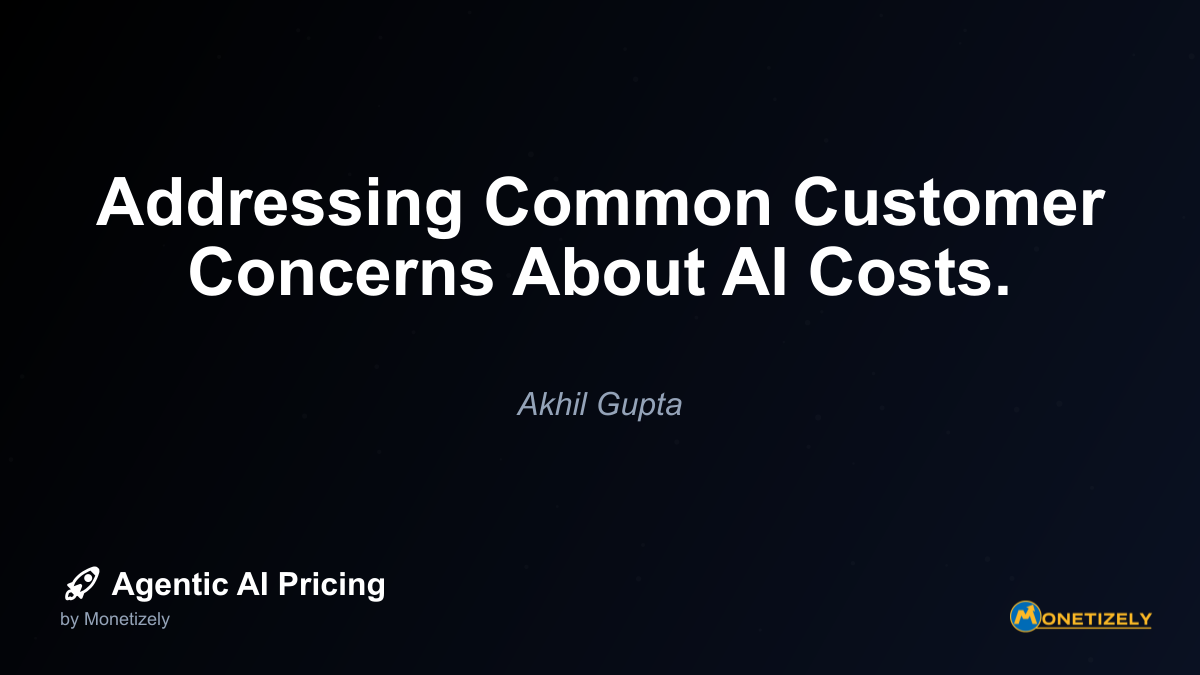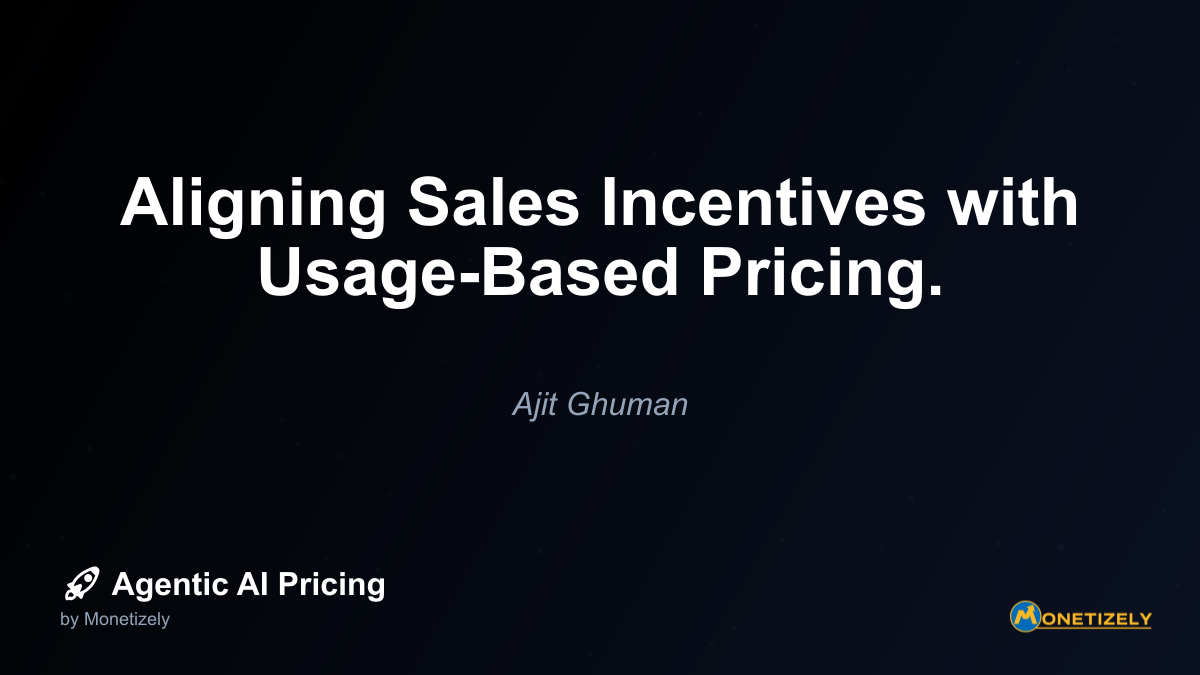· Ajit Ghuman · Best Practices · 10 min read
Balancing Simplicity and Fairness in Pricing.
AI and SaaS Pricing Masterclass
Learn the art of strategic pricing directly from industry experts. Our comprehensive course provides frameworks and methodologies for optimizing your pricing strategy in the evolving AI landscape. Earn a professional certification that can be imported directly to your LinkedIn profile.

Pricing is a delicate balancing act that can make or break your agentic AI product’s success in the market. On one hand, customers crave simplicity—pricing that’s immediately understandable and predictable. On the other hand, businesses need pricing that accurately reflects the value they deliver, which often introduces complexity. This tension between simplicity and fairness isn’t just a theoretical concern; it directly impacts customer acquisition, retention, and your bottom line.
For agentic AI solutions, this balancing act becomes even more challenging. These sophisticated systems deliver value in ways that can be difficult to measure and communicate, yet customers still expect transparent, straightforward pricing. How do you create a pricing structure that’s both simple enough for customers to understand and fair enough to reflect the true value of your offering?
The Simplicity Premium: Why Easy-to-Understand Pricing Matters
When potential customers encounter your pricing page, they’re making split-second judgments. Research from the Nielsen Norman Group suggests users spend an average of just 27 seconds on a website’s pricing page before deciding whether to engage further or bounce. This narrow window means simplicity isn’t just nice to have—it’s essential.
Simple pricing reduces cognitive load. When customers can quickly grasp how much they’ll pay and what they’ll get in return, they’re more likely to convert. Complexity, on the other hand, creates friction that can derail the purchase journey entirely.
Consider these benefits of simple pricing structures:
Faster decision-making: When pricing is straightforward, customers can make purchase decisions more quickly, shortening your sales cycle.
Reduced support burden: Simple pricing generates fewer questions and support tickets about billing and charges.
Increased trust: Transparent, easy-to-understand pricing builds credibility with potential customers.
Better word-of-mouth: Customers are more likely to recommend products with pricing they can easily explain to others.
Take Stripe’s payment processing as an example of simplicity done right. Their core pricing—2.9% + 30¢ per successful card charge—is memorably simple while still being tied to the value delivered (processing payments). This simplicity helped Stripe rapidly gain market share in a complex industry.
The Fairness Imperative: Why Value-Based Pricing Matters
While simplicity attracts customers, pricing that accurately reflects value delivered is what sustains your business. When customers feel they’re getting fair value for their money, they become loyal advocates. When they feel they’re paying too much for what they get, they become flight risks.
Value-based pricing—aligning what customers pay with the value they receive—offers several advantages:
Optimized revenue: By charging in proportion to value delivered, you capture more of the value you create.
Customer alignment: Customers who get the most value pay more, while those who get less value pay less.
Reduced churn: When pricing feels fair relative to value received, customers are less likely to leave.
Market segmentation: Different customer segments can pay different amounts based on the value they derive.
For agentic AI products, value often manifests in automation, insights, and outcomes that vary dramatically between use cases and customer segments. A one-size-fits-all approach frequently leaves money on the table or prices certain segments out of the market entirely.
The Complexity Conundrum: When Fair Pricing Gets Complicated
The pursuit of perfect fairness in pricing often leads to complexity. Consider an agentic AI system that helps companies optimize their supply chains. The value delivered might depend on:
- Number of products in the catalog
- Geographic distribution of warehouses
- Seasonality of demand
- Integration complexity with existing systems
- Frequency of inventory turnover
- Volume of transactions processed
A truly “fair” pricing model might incorporate all these variables to precisely match price to value. But presenting this to customers would result in a pricing calculator so complex that most would abandon it before understanding what they’d pay.
This is the complexity conundrum: the more precisely you try to align price with value, the more variables you introduce, and the harder your pricing becomes to understand.
Finding the Sweet Spot: Strategies for Balancing Simplicity and Fairness
The goal isn’t to choose between simplicity and fairness but to find an optimal balance—a pricing structure that customers can easily understand while still reflecting the value they receive. Here are strategies to help you strike that balance:
1. Use Tiered Pricing With Value-Based Tiers
Tiered pricing offers a middle ground between one-size-fits-all pricing and fully customized pricing. The key is to design tiers around value metrics that customers intuitively understand.
For an agentic AI customer service solution, instead of having complex formulas, you might create tiers based on:
- Basic: Up to 1,000 customer queries/month
- Standard: Up to 5,000 customer queries/month
- Professional: Up to 20,000 customer queries/month
- Enterprise: Unlimited queries with custom integration
This approach is simple to communicate while still roughly aligning with the value different customers receive.
2. Implement Value Metrics That Scale Naturally
Choose pricing dimensions that scale naturally with the value customers receive. Good value metrics have three qualities:
- Predictability: Customers can estimate their usage and costs
- Controllability: Customers can manage their usage to control costs
- Alignment: Usage correlates strongly with value received
For example, an agentic AI research assistant might charge based on the number of research queries processed rather than technical metrics like API calls or compute time. Customers intuitively understand that more research queries deliver more value, making this metric both simple and fair.
3. Use Add-Ons Instead of Multiplying Variables
Rather than creating a complex formula with multiple variables, consider a simpler base price with optional add-ons for specific features or capabilities.
For example, an agentic AI marketing tool might offer:
- Base package: Content creation and scheduling
- Add-on 1: Advanced analytics (+$X/month)
- Add-on 2: Competitor monitoring (+$Y/month)
- Add-on 3: Automated A/B testing (+$Z/month)
This approach keeps the core pricing simple while allowing customers to pay for additional value as needed.
4. Create Pricing Guardrails
Implement pricing guardrails to prevent customer surprises while still maintaining value-based pricing. These might include:
- Usage caps to prevent unexpected bills
- Price ceilings that limit maximum monthly charges
- Gradual tier transitions rather than sharp cliffs
- Proactive usage notifications before customers hit thresholds
These guardrails add a layer of predictability that customers appreciate without sacrificing the fundamental fairness of your pricing model.
5. Offer Multiple Pricing Models With Customer Choice
Sometimes the best approach is to offer customers a choice between simplicity and precision. For example:
- Option A: Simple flat-rate pricing (pay $X/month regardless of usage)
- Option B: Usage-based pricing (pay only for what you use)
This approach lets customers self-select into the pricing model that best matches their preferences and usage patterns. Those who value predictability can choose simplicity, while those who want to pay precisely for their usage can opt for the more complex model.
Case Study: How Leading Agentic AI Companies Balance Simplicity and Fairness
Case 1: The Transparency Approach
One leading agentic AI document processing company shifted from a complex pricing model with multiple variables to a simpler per-document fee structure with volume discounts. The company found that while the new model occasionally resulted in prices that weren’t perfectly aligned with costs, the increased conversion rate from having simpler pricing more than compensated for any margin variations.
The company maintained fairness by offering volume discounts that reflected their economies of scale and by creating separate pricing for documents with unusual complexity. This balanced approach resulted in:
- 37% increase in conversion rate on their pricing page
- 24% reduction in sales cycle length
- 18% decrease in billing-related support tickets
Case 2: The Hybrid Model
Another agentic AI company offering predictive analytics implemented a hybrid pricing model that combined simplicity and fairness. Their approach included:
- A simple base fee that covered core functionality
- Usage-based pricing for specific high-value features
- Quarterly true-ups rather than volatile monthly billing
This approach gave customers the predictability of knowing their minimum costs while still aligning pricing with value for power users. The company reported higher customer satisfaction scores and improved retention rates after implementing this balanced approach.
Implementation Guidelines: Transitioning to Balanced Pricing
If you’re looking to reform your pricing to better balance simplicity and fairness, follow these steps:
1. Audit Your Current Pricing
Begin by evaluating your current pricing structure against these criteria:
- Can a new customer understand your pricing in under 30 seconds?
- Does your pricing scale proportionally with the value customers receive?
- Are customers frequently surprised by their bills?
- Do sales conversations frequently get stuck on explaining pricing?
This audit will reveal whether you’re currently leaning too far toward complexity or oversimplification.
2. Identify Your True Value Drivers
Work with customers to understand what aspects of your solution deliver the most value. This research often reveals that the technical metrics you’re using for pricing (like API calls or storage) don’t align with how customers perceive value.
For agentic AI solutions, value drivers might include:
- Time saved through automation
- Quality improvements in outputs
- Strategic insights generated
- Business outcomes achieved
These value drivers should inform your pricing structure, even if they aren’t directly used as pricing metrics.
3. Prototype Multiple Pricing Models
Develop 2-3 alternative pricing structures that balance simplicity and fairness differently. For each model, create:
- A mock pricing page
- Sample customer scenarios showing what different customers would pay
- A comparison of revenue impact versus your current model
Test these prototypes with a mix of current customers, prospects, and internal stakeholders to gather feedback.
4. Plan for Graceful Transitions
When implementing pricing changes, grandfathering existing customers or offering phased transitions can maintain goodwill while moving toward a more balanced model. Consider:
- Giving existing customers the choice to stay on their current plan or switch
- Implementing changes only for new customers
- Providing transition discounts that gradually adjust to the new pricing
5. Monitor and Refine
After implementing your balanced pricing approach, closely monitor key metrics:
- Conversion rates on your pricing page
- Customer questions about pricing during the sales process
- Billing-related support tickets
- Churn patterns related to pricing concerns
Be prepared to make adjustments based on this feedback, continually refining the balance between simplicity and fairness.
Common Pitfalls to Avoid
In the pursuit of balanced pricing, watch out for these common mistakes:
1. The False Transparency Trap
Some companies create an illusion of simple pricing by hiding complexity in the fine print. This approach inevitably backfires when customers receive unexpected charges and feel misled. True simplicity doesn’t hide complexity—it thoughtfully reduces it.
2. The Premature Optimization Problem
Companies sometimes create overly complex pricing in an attempt to optimize revenue before they fully understand their value metrics. Start with simpler pricing and add complexity only when you have data showing it significantly improves fairness without hampering understanding.
3. The Competitor Copying Mistake
Copying competitors’ pricing structures without understanding their strategic rationale often leads to pricing that fits neither your business model nor your customers’ expectations. Your pricing should reflect your unique value proposition and customer relationships.
4. The Technical Metric Mismatch
Using technical metrics that are easy to measure but don’t align with customer value creates fundamental unfairness. For instance, charging for storage in an AI knowledge management system when the real value is in insights generated misaligns incentives and can drive customers away.
Conclusion: The Balanced Pricing Advantage
Finding the sweet spot between pricing simplicity and fairness isn’t just a theoretical exercise—it’s a competitive advantage. When you get this balance right, you create a virtuous cycle:
- Simple pricing attracts more customers and shortens sales cycles
- Fair pricing ensures customers feel they’re getting good value
- Satisfied customers become advocates who bring in more customers
- Growth provides resources to refine your pricing further
For agentic AI products, which often deliver value in complex and multifaceted ways, this balance is particularly crucial. The most successful companies in this space recognize that neither extreme simplicity nor perfect fairness should be the goal. Instead, they focus on creating pricing that’s simple enough to be understood at a glance while fair enough to align with the value customers receive.
By applying the strategies outlined in this article—tiered pricing based on value, naturally scaling metrics, thoughtful add-ons, appropriate guardrails, and customer choice—you can develop pricing that serves both your customers’ need for clarity and your business’s need for value-aligned revenue.
Remember that pricing is never “set it and forget it.” As your product evolves and your understanding of customer value deepens, continue to refine your approach to maintain the optimal balance between simplicity and fairness.
Co-Founder & CEO
Ajit is the author of Price To Scale, a top book on SaaS Pricing and is the Founder of Monetizely. Ajit has led and worked in pricing and product marketing at firms like Twilio, Narvar and Medallia. His work has been featured in Forbes and VentureBeat. Ajit regularly consults with software companies from Seed stage to post-IPO on pricing strategy. Ajit is also a highly-rated co-instructor for 'The Art of SaaS Pricing and Monetization' on Maven.
Pricing Strategy Audit
Let our experts analyze your current pricing strategy and identify opportunities for improvement. Our data-driven assessment will help you unlock untapped revenue potential and optimize your AI pricing approach.




